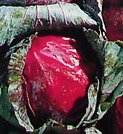Selection and storage

|
| Red-cabbage. |
Cabbage is a cool-season crop. In the US supermarkets, however, they can be readily available year-round. While buying, choose a fresh, compact, firm, medium-sized head, heavy for its size.
Pests are common in cabbage. Conventionally grown heads may be subjected to insecticide sprays to avoid pest infestation. Therefore wash thoroughly in cold running water, then soak in saline water for about 30 minutes. Then again, give a gentle wash in clean water in order to remove sand, dirt, pests, eggs/ova/cysts, and any residual insecticides.
Use cabbage while farm fresh to get its maximum health benefits. However, it can be stored in the refrigerator for a few days for later use.
Preparation and serving methods
To prepare, trim off the stem end and discard any withered outer layer leaves. Wash the head as described above. Cut the
head into two halves and then slice the leaves as you may desire in the recipes.
Here are some serving tips:
 |
| Sarmale, stuffed cabbage roll. Photo courtesy: Michaela. |
-
Thoroughly cleaned cabbage can be eaten raw, in fact, is very nutritious.
-
Add sliced or grated fresh leaves to vegetable salad preparations.
-
Raw sliced or chopped leaves can be added to vegetable salad preparations.
-
Fresh or pickled cabbage (sauerkraut) used as rolls in filling (sarmale) minced meat in many parts of Central Europe, Balkans, and Asia-minor regions.
-
Stew fried cabbage, onion, garlic, bell pepper, and green chilies mixed with steamed rice, and soy/chili/tomato sauce is one of the favorite dishes (Chowmein) in China and other South East Asian regions.
-
Furthermore, it is used in the preparation of a kind of soup with added beet juice, and yogurt is known as “borscht,” a very popular in eastern European nations.
Safety profile
Cabbage may contain “goitrogens,” certain plant-derived compounds, primarily found in cruciferous vegetables like cauliflower, broccoli, etc., which may cause swelling of the thyroid gland and should be avoided in individuals with thyroid dysfunction. However, they may be used liberally in healthy persons. (Medical disclaimer).
≻≻-Also read:- Sauerkraut Nutrition facts and Health benefits.
≻≻-Back to Vegetables from Cabbage nutrition. Visit here for an impressive list of vegetables with complete illustrations of their nutrition facts and
health benefits.
≻≻-Back to Home page.
Further Resources:
-
Stanford School of Medicine Cancer information Page- Nutrition to Reduce Cancer Risk.

